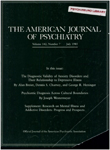The application of EEG sleep for the differential diagnosis of affective disorders
Abstract
On the basis of two EEG sleep criteria, REM latency and REM activity, the authors achieved 81% accuracy in distinguishing between 47 patients with primary depression and 48 patients with secondary depression using discriminant analysis. Sleep efficiency, the percentage of delta sleep, and the percentage of REM sleep discriminated between psychotic and nonpsychotic subgroups in the group with primary depression with 75% accuracy. REM activity and intermittent nocturnal awakening accurately discriminated two subtypes of patients with secondary depression at a level of 81%. These results suggest that EEG sleep measurements can yield significant data to aid in differential diagnosis in psychiatry.
Access content
To read the fulltext, please use one of the options below to sign in or purchase access.- Personal login
- Institutional Login
- Sign in via OpenAthens
- Register for access
-
Please login/register if you wish to pair your device and check access availability.
Not a subscriber?
PsychiatryOnline subscription options offer access to the DSM-5 library, books, journals, CME, and patient resources. This all-in-one virtual library provides psychiatrists and mental health professionals with key resources for diagnosis, treatment, research, and professional development.
Need more help? PsychiatryOnline Customer Service may be reached by emailing [email protected] or by calling 800-368-5777 (in the U.S.) or 703-907-7322 (outside the U.S.).



